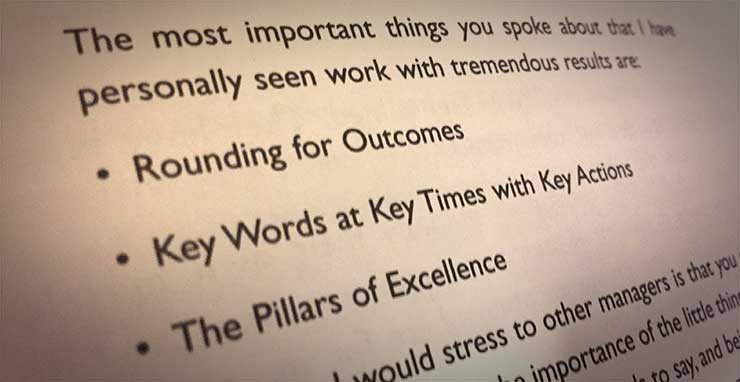Connecting Digital Rounding, AIDET’s, and Key Words at Key Times
When I was re-reading Chapter 3 of Hardwiring for Excellence, I connected with a letter written to to Quint from a director who attended one of his conferences. His name is Antonio and he spoke about three things he implemented in his department:
- Rounding for Outcomes
- Key Words at Key Times with Key Actions
- The Pillars of Excellence
Antonio explain how implemented these straggles helped him reduce turnover in his department to 5% from 15-20%, and now having a waiting list for those wanting to work in his department. There is are two points in this list that I think apply each day in the world of digital and social media communications for health care professionals.
Cipher Health shared in an article about digital rounding:
“Rounding is arguably one of the most important functions in a hospital. Whether it is unit, nurse manager, IT, or hourly rounding, it helps to understand what is working well in the hospital or if there might be an issue that needs to be addressed.”
Studer Group explains Rounding for Outcomes:
“The consistent practice of asking specific questions of key stakeholders—leaders, employees, physicians and patients—to obtain actionable information. Just as physicians round on patients, senior leaders can round in their divisions; unit leaders can round on their staff; leaders can round on ancillary departments they serve; and nurse leaders can round on patients.”
Rounding for outcomes can happen online in many different forms, especially with the use of AIDET’s. Some of you might ask, what does the acronym AIDET stand for?
“AIDET is an acronym that stands for Acknowledge, Introduce, Duration, Explanation, and Thank You.”
AIDET’s are typically used for physicians or clinicians as a methodology to use when entering a patients’ room. But now, AIDET’s are used virtually to allow the patient to interact with the clinician online when engaging patients, especially when marketing a new practice or service.
Here is a great example of an “marketing” AIDET video from Bon Secours St. Francis Health System in Greenville, SC
We welcome Dr. Manuel Dorna-Pesquera to the Bon Secours Medical Group and Reedy Family Medicine. Dr. Dorna-Pesquera is a…
Posted by Bon Secours St. Francis Health System on Monday, February 22, 2016
I love this example for a few reasons, especially when considering my communication model: audience, purpose, and delivery.
- Audience: New Prospective Patients
- Purpose: To introduce the physician and allowing prospective patients to get a sense of his “bedside manner” and demeanor.
- Delivery: Facebook is the distribution channel since the physician is a family medicine doctor. This is important given that the audience is prospective patients and where one of the key healthcare decision makers are women Millennials (age group 25-35), a large demographic on Facebook.
Here is a typical cross section of age demographics from most hospitals across the nation, this will give you some context.
So why do I like this so much and why does this relate?
- Dr. Manuel Dorna-Pesquera is using a similar format of an AIDET for his introductions to the community, a digital rounding methodology.
- This video is deployed natively inside Facebook instead of on a hospitals’ YouTube account. This is important because uploading and deploying natively inside Facebook allows the video to auto-play when the audience is scrolling down through the newsfeed.
- The first five seconds of the video are motion graphics, grabbing the attention of the audience, and if interested…they will click to listen toDr. Manuel Dorna-Pesquera. If they watch silently, they will see him smile and talk with a smile, gaining some visual insight into his bedside manner and demeanor.
- This deployment methodology for this piece of content allows the hospital to watch and see if it resonates with the audience, reviewing the analytics of how many times it was watched. If the content is viewed higher level of times (above average) indicating it is a good piece of content, they can then add some advertising dollars to the video growing the reach and refining the targeting to a specific demographic and geography. This allows the hospital to gain more access to analytics including how long people watched the video, which device gained the most views, and how many individuals clicked to learn more.
All of this is important because we are “Rounding for Outcomes,” more specifically digital rounding with digital content, tracking impact with the patient, and learning how to communicate affectively to the community.
From Cipher Health when talking about data and digital rounding:
“Collecting data is one of the best things a hospital can do. Data provides insights into hospital operations and gives meaning to improvement initiatives. By collecting data through rounds, hospitals can better understand what happens during a patient stay and then identify insights and trends. A digital rounding tool can make an everyday occurrence more meaningful and effective. The added benefits of collecting data and holding staff accountable help to improve both the patient experience and transparency within the hospital.”
Here is a great tool when thinking about AIDET’s and rounding from Studer Group’s Learning Lab: http://bit.ly/1KFBW08


